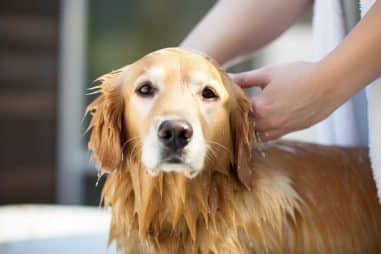Golden Retrievers are one of the most beloved dog breeds around the world. Known for their friendly demeanor, intelligence, and striking appearance, these dogs have captured many hearts. But breeding Golden Retrievers is not as straightforward as you might think. Responsible breeding involves thorough preparation, attention to detail, and a strong commitment to the health and well-being of the dogs. In this guide, you’ll find valuable information on genetic testing, how long Golden Retrievers are pregnant for, how many puppies they generally have, and how to care for both the mother and her new litter.
Why Choose to Breed Golden Retrievers?
People are drawn to Golden Retrievers for many reasons. They are charming, good with kids, and easy to train. But why would you want to breed them? Well, if you’re passionate about the breed, you might want to contribute to its longevity and quality. Good breeding keeps a breed strong and healthy. But remember, breeding is not just a hobby; it’s a full-time commitment.
You might notice that many people want to adopt or buy Golden Retrievers. The demand is there, but that also means you have a big responsibility. Breeding these dogs means you’re in charge of bringing healthy, well-adjusted puppies into the world. It’s a big job, but it can also be a rewarding one.
What to Know Before Breeding
Before you even think about breeding, there are some basics you should know. First, you should understand a bit about the genetics of Golden Retrievers. Knowing about any potential health problems can help you choose healthy parents for the puppies. Ask your vet for advice on what tests the parent dogs should go through. Common tests usually look for hip dysplasia and eye conditions.
Your home should also be well-prepared for a pregnant dog and her eventual puppies. You’ll need space, as a litter of puppies can take up quite a bit of room. You should also consider the costs. Breeding dogs isn’t cheap. Vet bills, quality food, and other supplies can add up. And don’t forget the time commitment. Puppies need constant care, especially in the first few weeks of their lives.
How Many Puppies Does a Golden Retriever Have?
So, you might be wondering about the size of a typical Golden Retriever litter. On average, these dogs tend to have between six to eight puppies. Sometimes the number can be as low as four or as high as twelve. A lot depends on the mother’s health, age, and even her own litter size when she was born.
But here’s the thing: the number of puppies can affect how you care for them. A large litter may mean that some puppies aren’t getting enough milk from their mom. In that case, you might need to step in and provide some bottle feeding. On the flip side, a smaller litter usually means more attention and food for each pup from their mom, making your job a bit easier. Either way, always have a vet check the mother and puppies soon after birth to make sure everyone is healthy.
How Long Are Golden Retrievers Pregnant For?
Golden Retrievers are usually pregnant for about 63 days, give or take a few days. Early on, you might notice your dog gaining a bit of weight and acting a bit differently. A vet can confirm pregnancy with an ultrasound and guide you on how to care for a pregnant dog.
During pregnancy, you’ll need to make some changes to your dog’s routine. More frequent, but less strenuous, walks are often advised. The diet will also change a bit; she’ll need more calories, but those extra calories should come from protein and not just larger portions of her regular food.
As the due date gets closer, your dog will need a comfortable place to give birth, also known as a whelping box. Keep tabs on your dog’s health and behavior, and always consult the vet if you notice anything unusual.
Preparing the Whelping Area
As the day of birth gets closer, you’ll need to set up a special area for your dog to give birth and care for her puppies. This is called a whelping box. Ideally, it should be about 1.2 meters by 1.5 meters (or 4 feet by 5 feet). Make sure the box is easy to clean and that it’s lined with soft, warm materials like towels or blankets.
This area should be peaceful and away from the hustle and bustle of the house. The mom-to-be will need a quiet space to focus on her babies. Make sure the area is warm, as newborn puppies can’t regulate their body temperature well. Regular cleaning is a must, too. A dirty whelping box could make the puppies sick.
The Birthing Process
The day has finally arrived! Your dog will show signs that labor is starting. She might seem restless, refuse to eat, or even start digging at her bedding. These are natural behaviors and usually mean that labor is just hours away.
Golden Retrievers go through different stages of labor. The first stage involves contractions and getting the puppies into position. The second stage is the actual birth of each puppy, followed by the third stage, which is the delivery of the placenta. Always be ready to assist, but remember that dogs have been giving birth without human help for a long time. However, if you notice any signs of distress or if labor is taking unusually long, consult your vet immediately.
After all the puppies are born, make sure each one is breathing and nursing. Clean them gently with a warm, damp cloth. The mother will do most of this work, but you should still monitor to ensure all is well.
Post-Birth Care and Socialization
Phew! You’ve successfully helped bring a new litter of Golden Retrievers into the world. But your job isn’t over. The first vet check should happen within a few days of birth. This is to make sure the puppies are healthy and to identify any potential issues early on.
The mother will need plenty of high-quality food and water as she’ll be nursing her pups quite a bit. And speaking of the pups, socialization starts now. The first few weeks of a puppy’s life are crucial for socialization. Even simple things like handling the pups and exposing them to different sounds can make a big difference.
At around four to six weeks old, you can start introducing solid food to the puppies. This is also when you’ll likely start showing the pups to potential new families. Make sure any interested parties are well-vetted. After all, you want to ensure each puppy goes to a loving forever home.
Conclusion
Breeding Golden Retrievers is a big task but one filled with many rewards. From understanding the genetics to taking care of a pregnant dog and then her puppies, each step requires careful planning and a commitment to excellence. Remember that each dog is unique, and while general advice is useful, nothing beats the advice and guidance of a qualified veterinarian. Congratulations on your successful journey into the world of dog breeding, and here’s to many more happy and healthy litters to come.








